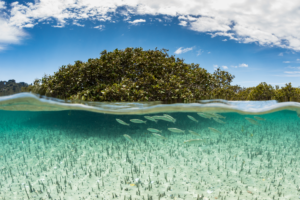
It is one of the most pressing questions of our time: How do we adapt to the impacts of climate change? October 2022 marked the return of The National Adaptation Forum, which brought together climate adaptation practitioners to share ideas, evaluate opportunities, and create synergies across occupations to try to answer that urgent question. The scale of the challenges is great and because of this, practitioners from artists and municipal officials to natural resource managers came together to work towards systems-level change.
Conservationists Kat Lyons and Mary Collins from the Center were among the diverse cadre of scientists and practitioners gathered in Baltimore, Maryland for this fifth National Adaptation Forum. The Forum provided Kat and Mary the opportunity to learn more about how to make their work climate informed, share what they have learned with others, and explore new and innovative adaptation approaches. They discussed key projects they have been working on at the Center and collaborated on the creation of an Adaptation Pledge (see below). Here, they each share a little bit about their participation in the Forum.
Kat Lyons, Conservation Project Coordinator, brought her experience facilitating the Appalachian Landscape Climate Advisory Group to the forum’s adaptation community.

Collaboration is a powerful tool needed to achieve collective action to meet the scale of the many challenges we face. The ability to collaborate with communities to work toward solving challenges is something we experience daily as individuals working across boundaries at the Center for Large Landscape Conservation. In my first year at CLLC as a project coordinator, I facilitated the Appalachian Landscape Climate Advisory Group, a coalition of 30+ experts across the eastern region to evaluate the importance of the Appalachians to mitigate and adapt to climate change. We came to the conclusion that there is a network of individuals, organizations, agencies etc. across this landscape that can collectively achieve much more alongside the communities who face the growing impacts of climate change. The upcoming report is a tool to be used by this network to integrate climate-smart actions into conservation strategies and strategic planning efforts. We don’t need to start from scratch but we need to actively listen, share resources and support communities on the front lines of these crises. We believe that collaboration is critical to enhance the climate resiliency of the Appalachian Landscape.
As a participant in this year’s forum, I took away a lot of names of experts, lists of decision-support tools and information to share with my colleagues but I also gained a better understanding of the networks we can work with outside of our field. We are living in a time where generations are coming together to acknowledge the significance of the impacts of a warming planet. We heard powerful presentations on how climate impacts are now being seen on the landscapes we care about. We heard from individuals who were overwhelmed by bad news and information. These individuals continue to ask, “What is my role and how can I contribute?” As a landscape conservation practitioner, the opportunities to engage communities at the local level, support regions with information sharing and integrate climate- smart actions into management or policy decisions at the national level are all opportunities we have to contribute. There is a lot to do, but we can achieve more together. – Kat Lyons
Mary Collins, International Program Conservation Associate, brought her experience integrating coastal and marine connectivity conservation into practice and policy to the Forum’s adaptation community.

Ecological connectivity, the unimpeded movement of species and the flow of natural processes, is a fundamental ecological process that sustains life on Earth and must be maintained, protected, and restored to achieve conservation and adaptation goals. The importance of connectivity to climate change adaptation and resilience has long been recognized on land, but is only just beginning to be leveraged for enhancing climate adaptation and resilience of marine and coastal ecosystems and the communities that depend on them. As species move in the face of changing ocean and coastal conditions, migratory connectivity pathways, connections to climate refugia, and safe routes for habitat retreat are becoming increasingly important to facilitate successful climate adaptation.
As a panelist in the session, Climate Impacts and Adaptation Strategies for Marine and Coastal Resources, I shared how coastal and marine connectivity can be applied as an essential tool to facilitate climate adaptation for habitats and species. I highlighted the application of ecological connectivity from terrestrial origins to coastal and marine disciplines and provided practical tools for managers and practitioners to integrate connectivity into their work. The Center along with the IUCN WCPA Marine Connectivity Working Group and partners are actively advancing this science and translating it into policy in the U.S. and internationally, with diverse lessons and cases drawn. To find out more, watch the recorded session presentation. – Mary Collins
Adaptation Pledge

National Adaptation Forum participants collaborated on the creation of an Adaptation Pledge to use as a tool for good practice. It is not a guide for best practice, rather, a philosophical framework within or upon which we can collectively work toward better long-term adaptation outcomes.
I pledge to create a durable future for my community and the environment, at home and at work, by thinking about the future in all I do.
I commit to:
- Use best available science and knowledge: Considering present, past, and future conditions in my actions.
- Decide with, not for: Invite, recruit and promote the broadest diversity of partners and stakeholders in conversations and decisions in my community.
- Build climate equity: Work to ensure the equitable sharing of the benefits of resilience-building and the equitable bearing of the costs of climate change.
- Safeguard integrity: Ensure transparency, accountability & follow-through.
- Minimize harm: Evaluate how actions might affect other people, living things, places, goals and endeavor to minimize adverse impacts while maximizing common benefits.
- Be honest about the challenges: Give voice to the fact that resilience requires adaptation to create it and mitigation to maintain it.
- Foster an inspired community: Use the knowledge that a long-term plan and vision that engages and inspires the community comes from tapping into hope and creativity.
- Adapt holistically: Your community is affected by & affects the world around you.
Photo, top: Appalachian mountains of North Carolina. Photo by Wendy Olson.



